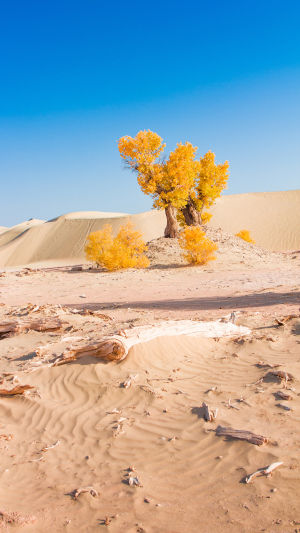Populus euphratica, a deciduous medium-sized natural tree, belongs to the angiosperm phylum and the genus Populus. It has a diameter that can reach 1.5 meters, with slender and softwood, and broad and fragrant leaves.
Populus euphratica is known for its resistance to drought and waterlogging, and its tenacity in life. It is one of the rare tree species in nature that can survive in harsh desert environments.
Populus euphratica is an ancient Mediterranean component, a remnant of the Tertiary Period that survived on the earth more than 60 million years ago.
It appeared successively in the coastal areas of the ancient Mediterranean and became an important component of small-leaf forests in mountain valleys. In the early and middle Quaternary, Populus euphratica gradually evolved into the most important constructive species of desert riparian forest.
Populus euphratica is the oldest kind of poplar that has been living on the earth for more than 130 million years. The lifespan of Populus euphratica can reach more than 200 years, and the longest-lived Populus euphratica tree has lived for more than 800 years.
Although it is far less long-lived than ginkgo and other longevity trees, it is already considered long-lived among Populus plants, most of which are fast-growing trees that age quickly, and generally have a lifespan of 30-40 years.
With the change in the earth's environment, Populus euphratica evolved to adapt to the drought, salinity, severe cold, and heat in the place where it lives. The roots, stems, leaves, and cells of Populus euphratica gradually evolved, making it the only tall deciduous tree that can grow in the desert.
The powerful root system of Populus euphratica plays an extremely important role in its ability to grow in arid desert areas. Its fleshy roots can absorb and store water easily, and can actively extend and grow towards areas with water.
The roots can penetrate more than ten meters deep and extend tens of meters outwards. The strong root system also has the ability to reverse osmosis, allowing it to maintain vitality even after being soaked in flood water for many days.
The branches of Populus euphratica can also respond to changes in water availability. When the water source is plentiful, the branches and leaves are luxuriant, and the trunk stores water for emergencies.
If there is a lack of water, it reduces the germination of branches and leaves, reduces water transpiration loss, and even cuts off some branches to strengthen the centralized water supply.
Some thick Populus euphratica will wither from the center, but the outer skin still transmits water and nutrients, keeping the canopy lush and healthy.
Populus euphratica wood is highly resistant to decay, especially after immersion in water, which enhances its corrosion resistance. In saline-alkaline areas, the wood of Populus euphratica is used as the basic material of bridges and culverts, lasting for a long time.
However, under the condition of impermanence in dryness and wetness, its corrosion resistance will be significantly reduced, and it will all rot in less than 2 years.
Populus euphratica forest is a unique and precious forest resource in desert areas. Its primary function is to prevent wind and sand fixation, create a suitable oasis climate, and form fertile soil. Populus euphratica is also known as the "Patron Saint of the Desert."
Populus euphratica plays a crucial role in stabilizing the ecological balance in the desert river zone, preventing wind and sand fixation, regulating oasis climate, and forming fertile forest soil. It is an ancient tree species that has important scientific value.





